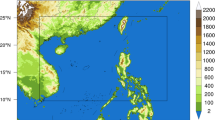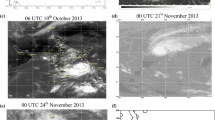Abstract
Typhoon Megi, the 13th typhoon of the 2010 typhoon season, was selected for case study by utilizing the Weather Research and Forecasting (WRF) model. Twelve sensitivity experiments with various initial tropical cyclone (TC) intensities and sizes were conducted to investigate their impacts on the simulation of typhoon track. Interaction between TC and the western Pacific subtropical high (WPSH) was also analyzed to explore the mechanism for the impact on TC track of the initial TC intensity and size. Numerical results indicate that the simulated TC size and TC track are sensitive to initial TC intensity and size. Stronger initial TC intensity and larger initial TC size often lead to larger simulated TC size and make TC turn northward earlier. Further analysis suggests that, with the increase of initial TC intensity and size, more air mass enters into the TC region, which subsequently reduces the extent of WPSH. As a result, the steering flow changes significantly and eventually causes the TC to turn northward earlier. The present study confirms that the initial TC intensity and size have certain influences on the TC track simulation, which demonstrates the importance of accurate initial condition for successful simulation of the TC intensity and TC track. Moreover, it also deepens our understanding of the interaction between TC and WPSH, provides helpful clues for the TC track change study, and discusses the future directions for improvement of TC track forecast.
Similar content being viewed by others
References
Chan, J. C. L., and W. M. Gray, 1982: Tropical cyclone movement and surrounding flow relationships. Mon. Wea. Rev., 110, 1354–1374, doi: 10.1175/1520-0493(1982)110<1354:TCMASF>2.0.CO;2.
Chou, M. D., and M. J. Suarez, 1994: An Efficient Thermal Infrared Radiation Parameterization for Use in General Circulation Models. NASA Technical Memorandum 104606, Greenbelt, Maryland, Goddard Space Flight Center, 85 pp.
Gopalakrishnan, S. G., F. Marks Jr, X. J. Zhang, et al., 2011: The experimental HWRF system: A study on the influence of horizontal resolution on the structure and intensity changes in tropical cyclones using an idealized framework. Mon. Wea. Rev., 139, 1762–1784, doi: 10.1175/2010MWR3535.1.
Grell, G. A., and D. Dévényi, 2002: A generalized approach to parameterizing convection combining ensemble and data assimilation techniques. Geophys. Res. Lett., 29, 38-1–38-4, doi: 10.1029/2002GL0153.
Hong, S.-Y., J. Dudhia, and S.-H. Chen, 2004: A revised approach to ice microphysical processes for the bulk parameterization of clouds and precipitation. Mon. Wea. Rev., 132, 103–120, doi: 10.1175/1520-0493(2004)132<0103:ARATIM>2.0.CO;2.
Janjić, Z. I., 2001: Nonsingular Implementation of the Mellor–Yamada Level 2.5 Scheme in the NCEP Meso Model. NCEP Office Note No. 437, 61 pp.
Lee, C.-S., K. K. W. Cheung, W.-T. Fang, et al., 2010: Initial maintenance of tropical cyclone size in the western North Pacific. Mon. Wea. Rev., 138, 3207–3223, doi: 10.1175/2010MWR3023.1.
Mellor, G. L., and T. Yamada, 1982: Development of a turbulence closure model for geophysical fluid problems. Rev. Geophys., 20, 851–875, doi: 10.1029/RG020i004p00851.
Mlawer, E. J., S. J. Taubman, P. D. Brown, et al., 1997: Radiative transfer for inhomogeneous atmospheres: RRTM, a validated correlated-k model for the longwave. J. Geophys. Res., 102, 16663–16682, doi: 10.1029/97JD00237.
Murata, A., K. Saito, and M. Ueno, 2003: The effects of precipitation schemes and horizontal resolution on the major rainband in Typhoon Flo (1990) predicted by the MRI mesoscale nonhydrostatic model. Meteor. Atmos. Phys., 82, 55–73, doi: 10.1007/s00703-001-0591-x.
Ren, S. L., Y. M. Liu, and G. X. Wu, 2007: Interactions between typhoon and subtropical anticyclone over western pacific revealed by numerical experiments. Acta Meteor. Sinica, 65, 329–340, doi: 10.11676/qxxb2007.032. (in Chinese)
Skamarock, W. C., J. B. Klemp, J. Dudhia, et al., 2008: A description of the advanced research WRF version 3. NCAR Technical Note NCAR/TN-475+STR, Boulder, CO, USA, 7–25.
Sun, Y., Z. Zhong, W. Lu, et al., 2014: Why are tropical cyclone tracks over the western North Pacific sensitive to the cumulus parameterization scheme in regional climate modeling? A case study for Megi (2010). Mon. Wea. Rev., 142, 1240–1249, doi: 10.1175/MWR-D-13-00232.1.
Sun, Y., Z. Zhong, and W. Lu, 2015a: Sensitivity of tropical cyclone feedback on the intensity of the western Pacific subtropical high to microphysics schemes. J. Atmos. Sci., 72, 1346–1368, doi: 10.1175/JAS-D-14-0051.1.
Sun, Y., Z. Zhong, L. Yi, et al., 2015b: Dependence of the relationship between the tropical cyclone track and western Pacific subtropical high intensity on initial storm size: A numerical investigation. J. Geophys. Res., 120, 11451–11467, doi: 10.1002/2015JD023716.
Yu, L. Y., and J. Fang, 2013: An analysis on the impact system of Typhoon MEGI (2010). J. Nanjing Univ. (Nat. Sci.), 49, 285–299, doi: 10.13232/j.cnki.jnju.2013.03.008. (in Chinese)
Yu, L. Y., and J. Fang, 2014: Environmental effects on the intensity of Typhoon Megi (2010). J. Nanjing Univ. (Nat. Sci.), 50, 113–128, doi: 10.13232/j.cnki.jnju.2014.02.001. (in Chinese)
Zhong, Z., 2006: A possible cause of a regional climate model’s failure in simulating the East Asian summer monsoon. Geophys. Res. Lett., 33, L24707, doi: 10.1029/2006GL027654.
Zhong, Z., and Y. J. Hu, 2007: Impacts of tropical cyclones on the regional climate: An East Asian summer monsoon case. Atmos. Sci. Lett., 8, 93–99, doi: 10.1002/(ISSN)1530-261X.
Author information
Authors and Affiliations
Corresponding author
Additional information
Supported by the National Natural Science Foundation of China (41605072 and 41430426) and Natural Science Foundation of Jiangsu Province (BK20160768).
Rights and permissions
About this article
Cite this article
Wang, Y., Sun, Y., Liao, Q. et al. Impact of initial storm intensity and size on the simulation of tropical cyclone track and western Pacific subtropical high extent. J Meteorol Res 31, 946–954 (2017). https://doi.org/10.1007/s13351-017-7024-3
Received:
Accepted:
Published:
Issue Date:
DOI: https://doi.org/10.1007/s13351-017-7024-3




